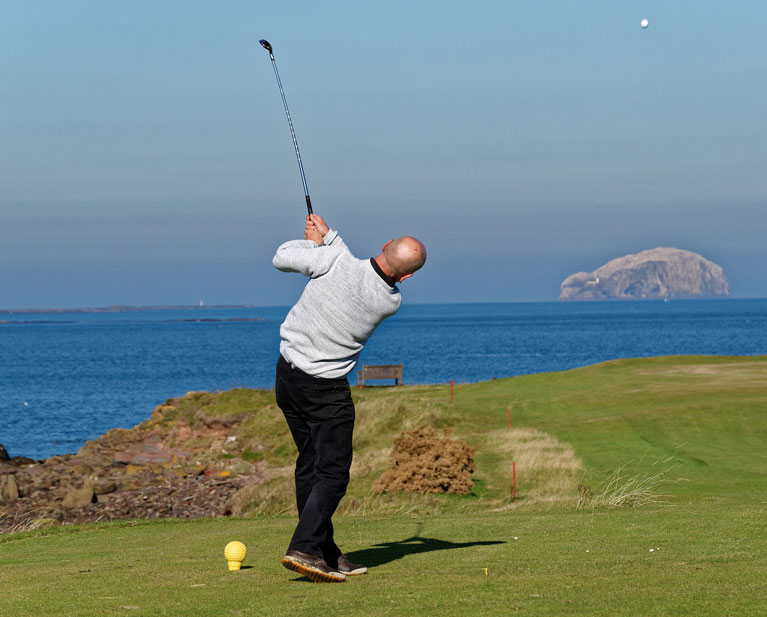Fall is a great season to play golf, but before you get on the course, you’ll want to make sure you’re playing safely. Preventing potential injury is essential whether you’re an experienced golfer or considering picking up clubs for the first time.
Here are some common golf-related injuries that can easily be prevented by taking proper precautions:
Golfer’s Elbow (Medial Epicondylitis)
About the Injury
A classic overuse injury, medial epicondylitis and lateral epicondylitis (also known as tennis elbow) occurs when the muscles in the forearm become tight and pull on their insertion, or where they attach.
This tightness can also occur from mechanical issues due to the golf swing such as cocking your wrist too much on the backswing or during the follow through. Gripping a golf club too tightly or striking an object or the ground with too much force can bring about this condition. Golfer’s elbow often presents as pain in your outer or inner elbow.
How to Prevent It
Avoid over practicing or practicing right before you play. The muscles of the forearm have become tight and weak so using them too much will only progress the injury. Stretching the forearm before and during your golf session can you help manage the tightness caused by playing.
Avoid is hitting on rubber mats at the driving range. Instead, opt for grass when hitting. The increased friction from a mat can add to the irritation. Be sure to check your grip during your swing— you may need to ease off a little or adjust your grip if you find you are holding on too tight.
Back Pain (Lumbar Strain)
About the Injury
Lumbar strain is one of the most common golf-related injuries due to the rotational component and volume of the sport. Symptoms of the injury vary from isolated pain in your lower spine to referred pain down your leg with no back pain, or even a full spasm bringing you to the floor. Issues such as muscle tightness, overswing, and weakness can all contribute to golfer back pain. Chronic back pain should be evaluated by a medical professional.
How to Prevent It
Harmful techniques such as poor posture, poor tempo and overswinging may contribute to back pain:
Mechanics
One area to address in preventing back pain is the mechanics of your golf swing. As most golfers know, your back is relatively straight in set up with the bend occurring at your hips. Hunching or rounding your back can cause strain.
Tempo
Another contributor is the tempo of your swing. You’ll want to make sure you are not utilizing one muscle group more than another, as this causes an imbalance. Additionally, overswinging can cause a pull or stress from an increase in force.
Flexibility
Flexibility can also be a major component in lumbar strain. If your hamstrings are tight and you are unable to flex at the hips, then you may need to get the motion from somewhere else, and often that is the back. You can address flexibility issues by stretching (hamstrings, quads, wrists, forearms, and shoulders) to improve your range and decrease pressure on the back.
A proper warm-up is crucial when trying to avoid injury. Warm muscles are more pliable than cold ones, therefore giving a better range for flexibility. A 10-minute warm-up consisting of light stretches with jumping jacks or a brisk walk can make all the difference. Strength training can also help prevent back pain as a strong core can minimize pressure on the lumbar spine.
Rotator Cuff Injuries (Sprain, Irritation, and Tears)
About the Injury
The rotator cuff is comprised of four muscles that work together to help keep the joint in place. With joints that have large amounts of mobility, they often lack stability from bony structures, and therefore the muscles do more of the work. The rotator cuff is not a group of muscles that one typically strengthens at the gym, so additional stress from swinging can compromise its integrity.
How to Prevent It
Stretch
As with a back injury, warm-up and stretching be extremely helpful for increasing muscle pliability before playing. Simple arm circles and bringing the arm across the chest and opening it in a doorway can add to its flexibility.
Adjust Your Swing
Golfers often use their shoulders to achieve rotation when the backswing lacks rotation, which adds pressure by compressing the rotator cuff anteriorly on the lead shoulder and overusing the muscles on the rear shoulder. To adjust for this issue, do not swing your arms after you stop turning your body. This helps stop the overturning that can occur when the trunk is not rotating enough on one’s backswing.
Consult A Physical Therapist
If you want to assess what’s holding you back from playing your best, reach out to your SetPT physical therapist today to learn more about ways to improve your golf game and prevent golf-related injuries.





